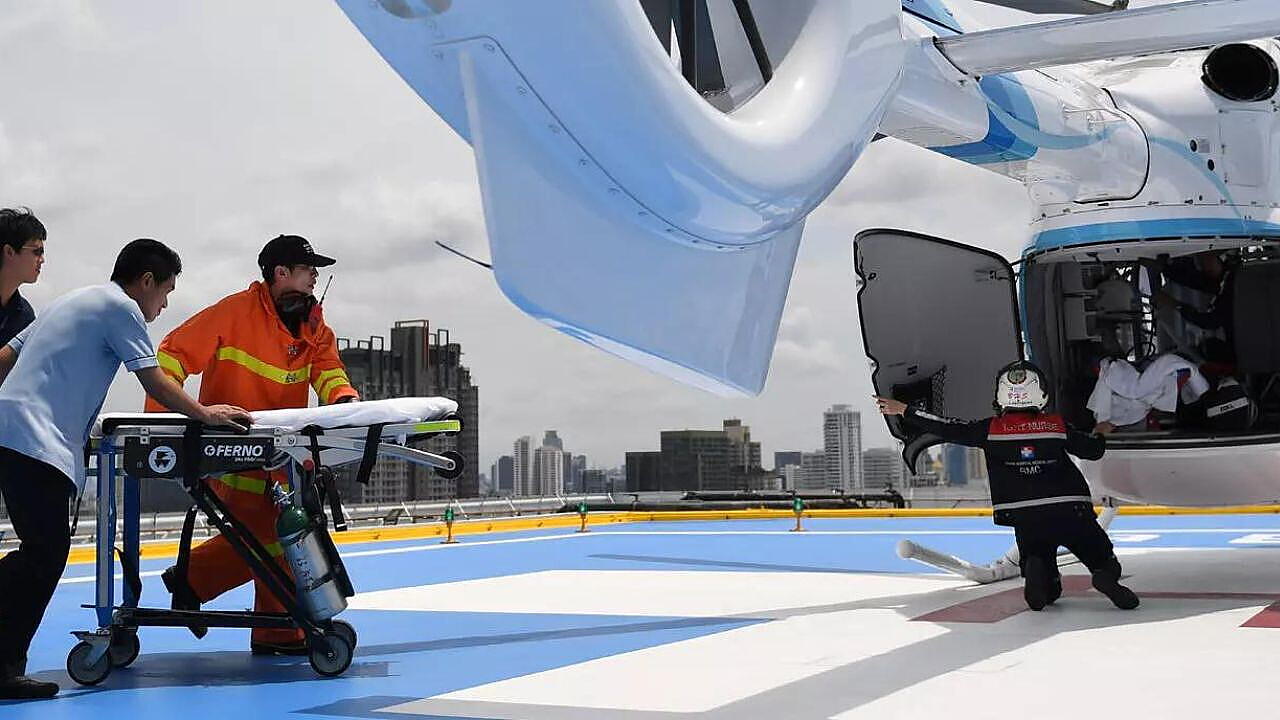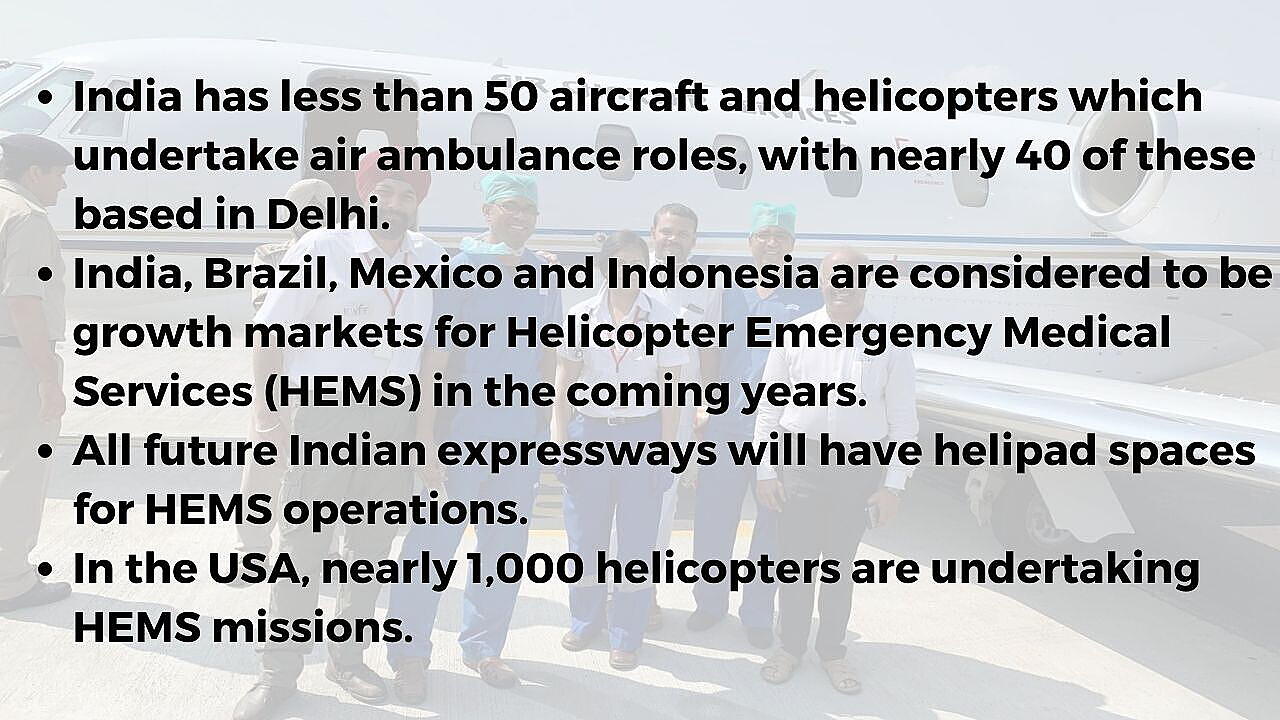
The use of air ambulances (aircraft and helicopters) globally has proven their efficacy in reducing response times to reach the critically injured and provide emergency treatment, in addition to transferring them from the scene of the incident to the appropriate hospital.
India’s landmass encompasses a unique blend of mountains, deserts and coastline with a huge amount of forest cover, which often makes road access for vehicles challenging or results in low speeds while traversing over rough terrain.
This difficult terrain is also typical of rural areas, where 70% of India’s population resides. Compared to a ground vehicle, a helicopter can reach a location three to five times faster, and in many cases, it is the only way to access inhospitable terrain speedily and safely to treat/evacuate a severely injured person. Once in the air, a helicopter can cover a distance of 125 km in 30 minutes.
Search And Rescue (SAR) operations in the case of emergencies and natural calamities are especially challenging, particularly in far-flung areas. Helicopters can bridge this gap. Despite several efforts by numerous companies and changes in Government policy, the market for emergency medical services using aircraft and helicopters has been slow to take off. Currently, the air ambulance and Helicopter Emergency Medical Services (HEMS) market in India remains largely underserved, but important steps are being taken to revitalise these services.
Ready For Growth
India today remains the only major economy to be underserved by air ambulance services, unlike the United States, Germany, United Kingdom, Japan, South Korea and China, which all have extensive air ambulance services available to their population. According to Airbus Helicopters, countries such as India, Brazil, Mexico, and Indonesia are potential candidates for strong HEMS development in the coming decades.
HEMS, in particular, is well-established in North America, Europe, Japan, Australia, and New Zealand. In the USA, for example, as of 2016, nearly 86% of its population was covered by an air medical service within a 15-20-minute response area.

China created the Beijing “999” Red Cross Emergency Rescue Center in 2001, which uses fixed-wing aircraft and helicopters, along with ambulances and motorcycles in emergency rescue and transportation. The “999” rescue centre was the first in China to deploy helicopters in 2014 and used Airbus-built H135 helicopters. Compared to Europe, which has nearly 900 helicopters configured for emergency medical services, China has around 90 helicopters. In the US, about 1,000 helicopters are operating in HEMS roles.
According to information provided by MoCA in March 2022, 49 air ambulances (aeroplanes and helicopters) were operated by 19 non-scheduled operators in India. The state-wise split of these air ambulances was Delhi (39), Gujarat (1), Kerala (2), Maharashtra (5), Odisha(1) and West Bengal (1). Around 4,100 patients have hired ambulances during the last three years.
Airbus Helicopters is a leading producer of HEMS helicopters, supplying over 60% of the approximately 2,600 rotorcraft utilised worldwide in emergency medical operations. The Airbus Foundation has also sponsored HEMS training in Brazil, China, India, Indonesia, and Mexico since 2015.
New Initiatives
Speaking at the 4th Heli-India Summit in October 2022, Civil Aviation Minister Jyotiraditya Scindia said his ministry had worked closely with the Ministry of Road Transport & Highways (MoRTH) to allot helipad spaces from the design stage for all future expressways and major highways so that they can be used for the evacuation of accident victims. Some of these expressways include the Delhi-Bombay Expressway, Ambala-Kotputli Expressway, and Amritsar - Bathinda - Jamnagar Expressway.
According to information released by MoRTH, there were approximately 1.3 lakh fatalities and 3.4 lakh people injured in road accidents in 2020. Scindia also stated that the Government has waived off landing and parking charges for helicopters at airports and has started helicopter sensitisation training of Air Traffic Control (ATC) officers for speedier traffic handling.
Three helicopter corridors from Mumbai-Pune, Ahmedabad-Gandhinagar, and Shamshabad-Begumpet have also been created, and new Instrument Flight Rules (IFR) corridors are being planned. These efforts will aid in the growth of helicopter operations in the country. In all, less than 250 helicopters are operational in India across 73 operators. Moreover, the industry is highly fragmented, with only three operators having more than ten helicopters.

Scindia also said that the Ministry of Civil Aviation (MoCA) had decided to incubate a HEMS pilot called ‘Project Sanjeevani’ by deploying a helicopter to provide emergency medical services at the All India Institute of Medical Sciences (AIIMS) Rishikesh. The pilot project was slated to begin in November last year, with a helicopter based at the hospital and ready to operate at 20 min notice. It would cover a service area in a 150 km radius.
The Minister said that the Government intended to expand medical outreach and access to trauma care services to a wider population base across the country using the speed advantage and mobility of helicopters. He said the Government would use the learnings from Project Sanjeevani to explore the concept's viability, its benefits, and the attendant risks and later articulate a national policy on HEMS before committing larger resources. In March 2022, Airbus entered into an MoU with Airlift Global, backed by the UK-based AUM Capital, to foster HEMS and associated air medical services in India.
Sunny Guglani, Head - Airbus Helicopters, Airbus India and South Asia, said, “HEMS is a globally established best practice. There is an urgent need for this service in India. HEMS can save lives by ferrying patients and/or accident victims within the ‘Golden Hour’, help in organ transportation and taking healthcare to the remotest parts of our country. An HEMS ecosystem needs to be built in India in partnership with Government bodies, global service providers and helicopter OEMs. Our partnership with Airlift Global is a step in the direction of developing this critical segment of healthcare in India.”
Airbus and Airlift Global will also conduct joint research on HEMS and air ambulance services and will encourage the standardisation of operations of these services with established healthcare and related service providers.
The Indian Navy has also fitted its indigenously developed ALH ‘Dhruv’ Mk III helicopters with Medical Intensive Care Units (MICU). In May 2021, it showcased an ALH Mk III from INAS 323 fitted with a MICU at INS Hansa in Goa. The MICU has two sets of defibrillators, multiple monitors, a ventilator, oxygen support, and infusion and syringe pumps.
Hindustan Aeronautics Limited is to deliver eight MICUs to HAL for installation on its Dhruv helicopters. Reconfiguring a navy Dhruv helicopter with the MICU will take 2-3 hours. The helicopters can evacuate critically ill patients when equipped with the MICU.
Also Read:
Airbus Selects L&T Technology Services As Strategic Engg Partner
Tata Boeing Aerospace Delivers First AH-64 Helicopter Fuselage To Indian Army
Indian Multi-Role Helicopter Project Progresses With Engine Agreement